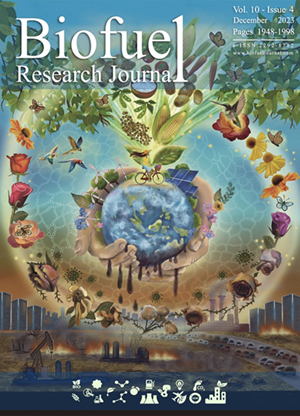在喷口直径和EGR改性直喷柴油机上对麻花油生物柴油-柴油混合燃料的燃烧特性进行了实验研究
IF 11.9
Q1 ENERGY & FUELS
引用次数: 29
摘要
通过减小喷嘴孔径(NHD)(即,从0.28的基本值到0.20mm的修正值)来改进发动机已被证明是改善发动机性能、燃烧和排放参数的有效策略。然而,它也导致NOx排放量的大幅增加,这是一个主要缺点。有鉴于此,本研究旨在通过应用部分冷却的废气再循环(EGR)系统来克服这一挑战。更具体地说,在五种不同的发动机负荷(即2.46、4.92、7.38、9.84和12.3kg)和不同EGR率(即10%、20%和30%)下,在改进的单缸柴油发动机上测试了马华油-生物柴油-柴油混合物(B20)和纯柴油。所获得的结果表明,与传统柴油发动机(孔径为0.28mm的3孔喷嘴)相比,除了NOx的情况外,改进的发动机(孔径直径为0.20mm的3孔喷嘴)的纯柴油和B20的性能、燃烧和排放特性都得到了改善。通过实施部分冷却的EGR,可以成功地补偿由较小孔口NHD引起的NOx排放的显著增加。总的来说,根据本研究的结果,建议在部分冷却EGR率为10%的情况下对发动机进行改造,作为20%的马华油生物柴油和柴油混合物的有效燃烧条件。然而,由于大量未燃烧的烟灰、CO2、H2O以及O2缺乏的再循环,EGR率的进一步增加,特别是在较高负载下,对改进的发动机的性能和排放特性产生不利影响。本文章由计算机程序翻译,如有差异,请以英文原文为准。
Experimental investigation of the combustion characteristics of Mahua oil biodiesel-diesel blend using a DI diesel engine modified with EGR and nozzle hole orifice diameter
Engine modification through reducing nozzle hole diameter (NHD) (i.e., from the base value of 0.28 to the modified value of 0.20 mm) has been shown as an effective strategy in improving engine performance, combustion, and emission parameters. However, it has also led to substantial increases in NOx emission as a major shortcoming. In light of that, the present study was aimed at overcoming this challenge through the application of a partially-cooled exhaust gas recirculation (EGR) system. More specifically, Mahua oil biodiesel-diesel blend (B20) and neat diesel were tested on a modified single cylinder diesel engine under five different engine loads (i.e., 2.46, 4.92, 7.38, 9.84, and 12.3 kg) and in the presence of varying EGR rates (i.e., 10, 20, and 30%). The results obtained revealed that the performance, combustion, and emission characteristics of the modified engine (3-hole nozzle with an orifice diameter of 0.20 mm) were improved for both neat diesel and B20 except in the case of NOx, in comparison with those of the conventional diesel engine (3-hole nozzle with an orifice diameter of 0.28 mm). The considerable increases in NOx emissions caused by the smaller orifice NHD could be successfully compensated for through the implementation of the partially-cooled EGR. Overall and based on the findings of the present study, the proposed engine modification in the presence of partially-cooled EGR rate of 10% could be recommended as efficient combustion conditions for 20% blend of Mahua oil biodiesel and diesel. However, further increments in the EGR rate and in particular at higher loads, adversely affected the performance and emission characteristics of the modified engine due to the recirculation of high amounts of unburnt soot, CO2, H2O, as well as of O2 deficiency.
求助全文
通过发布文献求助,成功后即可免费获取论文全文。
去求助
来源期刊

Biofuel Research Journal-BRJ
ENERGY & FUELS-
CiteScore
22.10
自引率
1.50%
发文量
15
审稿时长
8 weeks
期刊介绍:
Biofuel Research Journal (BRJ) is a leading, peer-reviewed academic journal that focuses on high-quality research in the field of biofuels, bioproducts, and biomass-derived materials and technologies. The journal's primary goal is to contribute to the advancement of knowledge and understanding in the areas of sustainable energy solutions, environmental protection, and the circular economy. BRJ accepts various types of articles, including original research papers, review papers, case studies, short communications, and hypotheses. The specific areas covered by the journal include Biofuels and Bioproducts, Biomass Valorization, Biomass-Derived Materials for Energy and Storage Systems, Techno-Economic and Environmental Assessments, Climate Change and Sustainability, and Biofuels and Bioproducts in Circular Economy, among others. BRJ actively encourages interdisciplinary collaborations among researchers, engineers, scientists, policymakers, and industry experts to facilitate the adoption of sustainable energy solutions and promote a greener future. The journal maintains rigorous standards of peer review and editorial integrity to ensure that only impactful and high-quality research is published. Currently, BRJ is indexed by several prominent databases such as Web of Science, CAS Databases, Directory of Open Access Journals, Scimago Journal Rank, Scopus, Google Scholar, Elektronische Zeitschriftenbibliothek EZB, et al.
 求助内容:
求助内容: 应助结果提醒方式:
应助结果提醒方式:


